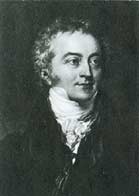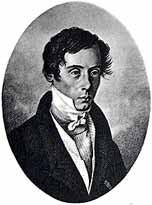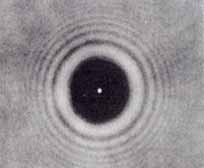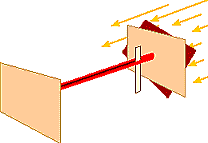![]()
![]()
Anthropologists suggest that the ability of humans to detect color perhaps evolved when distant ancestors lived in trees and found it helpful to distinguish fruit from leaves. But successful understanding of color and color vision was long an enigma for humans. Basic understanding of colored light is only a couple centuries old. And some people believe that common explanations about color vision are STILL flawed!
Robert Hooke (1635-1703) who started as an assistant to Robert Boyle, published in 1667 an explanation of light as waves. White, natural light
according to Hooke is a simple uniform pulse at right angles to the direction of propagation. Blue light is a confused pulse whose weakest part precedes and whose strongest follows. Red light is a confused pulse whose strongest part precedes the weakest part.
Refraction changed the light's color.
Before publication of Hooke's ideas, Isaac Newton (1642-1727) began experiments with triangular glass prisms which were long known to produce colors like a rainbow. But the long, narrow non-circular shape of the spectrum produced was not like the rainbow he expected. Placing two prisms back to back, Newton was able to reconstruct a spectrum of colors back into white light except when some colors were blocked. As a result Newton proposed that white light is a mixture of every variety of color. According the Newton, color is not mutable; refraction such as occurs in a prism separates but doesn't change color. Newton suggested corpuscles
of different size carry color with red the largest and deep violet the least.
 Christiaan Huygens (1629-1695) developed in 1678 a greatly improved wave theory which wasn't published until 1690 in Leyden. Because intersecting beams of light do not interfere with each other, Huygens believe light was more likely a wave motion in a medium rather than a
Christiaan Huygens (1629-1695) developed in 1678 a greatly improved wave theory which wasn't published until 1690 in Leyden. Because intersecting beams of light do not interfere with each other, Huygens believe light was more likely a wave motion in a medium rather than a flight of arrows
as conceived in the corpuscular theory by Newton. But the controversy continued for over a century with most preferring Newton's views. Both theories seemed to explain the known phenomena of light.
A century passed. Between 1802 and 1804 the Englishman Thomas Young (1773-1829, shown at right), linguist, physician, and expert in many fields, investigated the phenomenon of interference of light. Young found convincing evidence that this property could only be explained in terms of waves. He further demonstrated that all of Newton's experiments with light also could be explained in terms of waves. On November 24, 1803, Young presenting an experiment demonstrating the wave nature of light to the Royal Society of London. His audience included many scientists, most preferring Newton's corpuscular theory because light is always observed to travel in straight beams in contrast to the ripple-spreading behavior which Christian Huygens had linked with wave motion. Young received much ridicule and hostility for his claims. Most people continued to prefer the corpuscular explanations of the great Newton.
 As a physician Young had studied the eye. Based on that knowledge, Young went on to develop a three-color explanation for color vision which is still accepted today.
As a physician Young had studied the eye. Based on that knowledge, Young went on to develop a three-color explanation for color vision which is still accepted today.
 Fifteen years later, Augustin Jean Fresnel (1788-1827, shown at left) in his spare time developed a comprehensive mathematical wave model for light. But several fellow Frenchmen thought mathematics could prove the superiority of the particle model of light. Simon Poisson used Fresnel's own equations to demonstrate that they made an absurd prediction: If a narrow beam of light were shown upon a small object, waves would diffract around the object and constructively interfere in the middle of the shadow, making a bright spot there. When the experiment designed to demonstrate the folly of the wave theory was carefully conducted, the spot actually OCCURRED (see photograph) CONFIRMING the wave model instead of showing it wrong! Also note the rings around the shadow also caused by diffracted light waves. (This photograph was made using an light sensitive emulsion outside of a camera in a very dark room. The photographic film was located in the shadow of a pea sized ball then illuminated briefly from across the room with a dim light filtered to a single color.)
Fifteen years later, Augustin Jean Fresnel (1788-1827, shown at left) in his spare time developed a comprehensive mathematical wave model for light. But several fellow Frenchmen thought mathematics could prove the superiority of the particle model of light. Simon Poisson used Fresnel's own equations to demonstrate that they made an absurd prediction: If a narrow beam of light were shown upon a small object, waves would diffract around the object and constructively interfere in the middle of the shadow, making a bright spot there. When the experiment designed to demonstrate the folly of the wave theory was carefully conducted, the spot actually OCCURRED (see photograph) CONFIRMING the wave model instead of showing it wrong! Also note the rings around the shadow also caused by diffracted light waves. (This photograph was made using an light sensitive emulsion outside of a camera in a very dark room. The photographic film was located in the shadow of a pea sized ball then illuminated briefly from across the room with a dim light filtered to a single color.)
According the wave theory of light, different colors of light are carried by waves of different lengths, that is, the distance from one wave to the next.
If the wave model of light proposed by Young and Fresnel is correct, then under appropriate conditions we should be able to observe interference of light and estimate the size of the light waves.
 If light waves of similar size originate at two locations (the red and blue dots on the diagram), the emerging waves create an interference pattern. Note that on the left side of the diagrams circular waves can be seen having been previously generated at the red and blue dots. When these waves meet destructively a wave crest meets a wave trough, the sum of the two wave amplitudes is zero and the waves cancel at that location. This creates regions of very low wave intensity which are called nodes. Such a node region can be seen on the right of the diagram at
If light waves of similar size originate at two locations (the red and blue dots on the diagram), the emerging waves create an interference pattern. Note that on the left side of the diagrams circular waves can be seen having been previously generated at the red and blue dots. When these waves meet destructively a wave crest meets a wave trough, the sum of the two wave amplitudes is zero and the waves cancel at that location. This creates regions of very low wave intensity which are called nodes. Such a node region can be seen on the right of the diagram at N.
At other locations crests from each source meet and constructively interfere forming a wave with amplitude the sum of each individual wave. A moment later the following troughs meet at that location and also constructively interfere. The result is regions of large waves known as antinodes. Such a region can be seen on the right of the diagram at A.
Similar interference patterns occur when a wave diffracts passing by an object which casts a shadow or when a wave diffracts passing through a narrow slit.
Some of the procedures further down the screen are more challenging. But here is one of the simplest ways to see direct evidence requiring light waves.

According to Walter Scheider, in a The Physics Teacher article, Do the Double Slit Experiment the Way it Was Originally Done
, Young split a narrow beam of sunlight with what is described as a slip of card, about one thirtieth of an inch in breadth (thickness).
The slip of card was held edgewise into the sunbeam, which was made to enter the room horizontally by means of a looking glass
(mirror) and a tiny hole in a window shutter
. The sunbeam had a diameter slightly greater than the thickness of the card. When the card was placed properly it split the beam into two slivers, one passing on each side of the slip of card. An interference effect was observed on a screen placed to receive the light beams. In the modern version Scheider suggests using a laser to provide a single color of light. Perhaps an inexpensive laser pointer used for group presentations could substitute for the beam of sunlight.
λ = t • sine θ
where sine θ = distance between successive antinodes / distance from source to screen.
Consider the significance of finding something so small as the size of a light wave!
Which colors have the longest and shortest wavelengths?
Colors
The Herschel Experiment allows you to reproduce Frederick William Herschel's (1738-1822) experiment in which in 1800 he discovered infrared light. (available via link to ipac@caltech)
The Ritter Experiment allows you to reproduce Johann Wilhelm Ritter's (1776-1810) experiment in which in 1801 he discovered ultraviolet light. (available via link to ipac@caltech)
Double SlitExperiment the Way it Was Originally Done, The Physics Teacher vol 24, 217-219, 1986
![]()
to next Experiment
to ie-Physics menu
to site menu